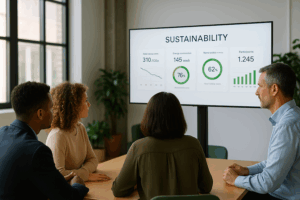Creating a culture of sustainability is a matter of many things, namely, a strong alignment between employees’ values and outlook on social and environmental issues, and the sustainability values and objectives laid out in the corporate ESG strategy. Nonetheless, there is a very subtle but crucial difference that sets apart such alignment from employees’ active engagement in the sustainability strategy. But, how can companies approach and overcome this key gap between mindset and action?
Table of Contents
The need to align corporate sustainability objectives with employees' values and expectations
We are starting off this text with a pretty straightforward statement that we believe to be true and essential to the development of corporate ESG goals: companies need to align corporate sustainability objectives with their employees’ values and expectations on social and environmental matters.
We could even go further to state that such an alignment needs to happen across a wide variety of stakeholders, internally as well as externally, but for the sake and length of this article we will continue down the employees’ path.

The idea here is quite simple; employees, as individuals with their own unique set of values and beliefs, want to feel a sense of moral and personal alignment with the company they work for. This is not to say that they want to blindly follow and agree with everything the company does or says, instead, people look for a sense of community.
And so, the need to align sustainability and general corporate values and objectives with employees’ own values and expectations is not a means for control or moral rigidity within corporate grounds, but rather a way to build a community around strong and responsible moral grounds.
And if something distinguishes a community-like environment from ‘herds’ (aside from the obvious differences), is that there is room for communication, growth and feedback. This is, alignment should not be forced upon people form the top down, but rather be build on collaboration and transparency.
The difference between alignment and active engagement
The difference between alignment and engagement is sometimes blurred, and many times companies are completely unaware of the crucial difference that sets alignment apart from actually developing strategies that help actively involve employees in ESG matters.
But why should employee engagement be at the top of companies’ priorities, you may ask; well, according to a recent report on the state of ESG 2024, which focuses on the most common corporate sustainability challenges, engaging internal stakeholders with a pro-active approach was among the most prominent obstacles businesses faced in their path towards sustainability.
Engage employees in the sustainability strategy
Long gone are the days where aligning corporate and employee values was the primary issue. Although it is still a work-in-progress assignment for many, both society and the corporate world are progressively tilting their demands and objectives, respectively, towards the need for sustainable business practices, which makes said alignment much easier and even natural.
But the real and more complex problem today is being able to leverage such alignment and conviction and transform it into tangible action and ESG impact.
In order to understand why this is the reality for many businesses, it is interesting to look at perhaps the most important difference we can find between those who profess alignment and those who look for active engagement among their employees, and that is the difference between passive and active contributors.
Passive and active contributors
Employees who are merely aligned with the sustainable purpose and values of the company are, for the most part, passive contributors to the overall ESG strategy. This means that while they won’t act as an obstacle for the achievement of corporate goals, neither will they contribute to any of the set KPIs or strategic sustainability pillars, at least not significantly.
On the other hand, employees who are encouraged and invited to be involved in the definition or achievement of corporate sustainability goals, can quickly become active contributors in the process of both developing and implementing the ESG strategy. This contribution, however, can be limited by solely engaging employees in the implementation, while leaving them outside of the development process; which is not rare nor mistaken.

Why companies should prioritize employees' active engagement
But, if you are still wondering why companies should start prioritizing employees’ active engagement, here are a few reasons why your company should start developing engagement strategies today:
- Employees’ active engagement is necessary in the current regulatory landscape. As we’ve touched upon before, stakeholder engagement is an inseparable element of conducting a successful and insightful Double Materiality Assessment. Building proactive engagement strategies with employees can ensure there is no bias in their contribution to DMAs, as well as guarantee extensive participation in developing this analyses necessary for the CSRD or the CSDDD, for example.
- Employee engagement can help improve and advance overall ESG endeavors while being a key pillar to the ‘S’ itself. While contributing to the sustainability strategy, employees are, at the same time, becoming key allies to Social matters within the company such as employee retention, employee up-skilling or leadership development.
- Building purposeful relationships that empower employees. Engaging employees in sustainability matters that are strategic to company success can help further support the feeling of purpose people look for in their jobs, as well as secure the trust they need from employers or managers to feel empowered. This contribution can also serve as a means for rewarding individuals’ efforts and achievements, which is, in and of itself, a key element for employee wellbeing.
- Creating a sense of ownership and personal connection to strategic sustainability achievements. Engaged employees feel more connected and put more value into what they are doing when they know they are an active part of its attainment and success. This is known as the endowment effect (also known as the IKEA effect), which states that the way we value things is directly linked and proportionate to the level of implication we have on a given matter or action.

Here is how DoGood can help you engage your workforce in the sustainability strategy
In DoGood, we aim to simplify the complex web of sustainability objectives for companies by offering a platform that translates the high-level ESG (Environmental, Social, Governance) objectives into actionable tasks for every single employee.
Then, each employee not only knows how to make an impact but also feels empowered to contribute meaningfully to the greater sustainable strategy.
No more vague directives. No confusion. DoGood automates the process, making it seamless for the workforce to know precisely what steps to take.
You might also like…

Adapting to the Gen Z Workforce: Strategies for Integration and Engagement

Sustainability KPIs: How to Make Employees Accountable

5 Innovative strategies HR leaders can implement today to drive corporate sustainability

Why CFOs must take the lead in corporate sustainability (before it’s too late)

Sustainability in hospitality: upskilling your workforce for lasting impact

